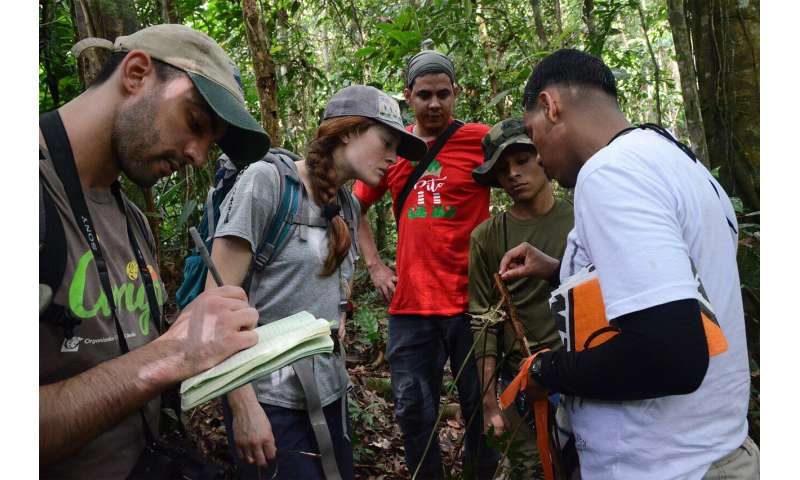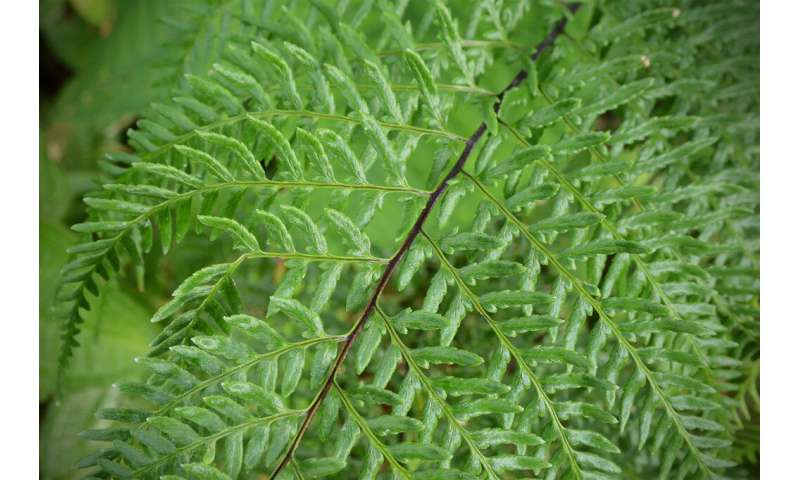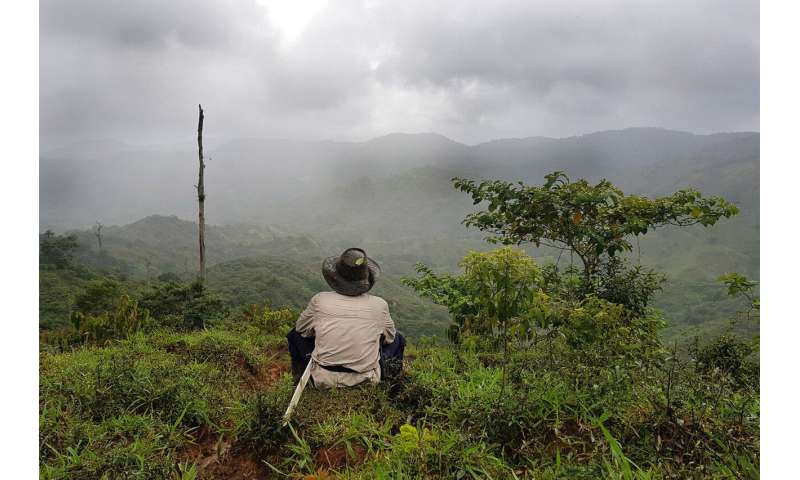Panamanian field expeditions examine how species persevere in face of climate change
Ben Goulet-Scott, a Ph.D. candidate in the Graduate School of Arts and Sciences' Department of Organismic and Evolutionary Biology (OEB) and a fellow in the Arboretum's Hopkins Lab, and Jacob Suissa, OEB Ph.D. candidate in the Friedman Lab at the Arboretum, hope their research in the Mamoní Valley Preserve in Panama will increase our understanding of how biodiversity can persevere in the face of climate change, deforestation, and human disturbance.
The 20-square-mile land conservancy on the isthmus separating Central and South America teems with life, making the condensed rainforest habitat a perfect location for their research project because of the vast number of known and potentially undiscovered species living there, Goulet-Scott said.
"New England has twice the land area of Panama, but half the number of bird species, and 10 times fewer reptiles and amphibians," he said. "This particular location contains species that migrate or move from north to south and get funneled into this very narrow area, concentrating an incredible amount of biodiversity."
The Mamoní Valley Preserve (MVP) Natural History Project is an ongoing series of student-led field expeditions, organized by Goulet-Scott in 2017. The project is designed to establish a baseline understanding of how the different land-use conditions within the preserve—from fully deforested cattle pasture to recovering secondary forest and intact primary forest—affect patterns of diversity.

By bringing early career biologists like himself to the site for fieldwork, Goulet-Scott is building a list of species and observations to eventually make available in a central repository for scientists and researchers focused on conservation.
"Identifying every species there is actually probably not possible, but that's how we think about the mission of these trips," he said. "By bringing groups of students who have expertise in identifying different types of organisms, we work to document all the different species we see in each type of habitat."
Creating a baseline is vital because it will help determine which areas are of high priority for conserving certain species, and which species might already be threatened.
"It's an interesting exploration," Goulet-Scott said. "The more frequently we do biodiversity studies, the better we are able to track how conservation is going in this area."
The MVP Natural History Project intrigued Robert Brooker, M.B.A., who learned about Goulet-Scott's research and funded this expedition.

"I met Ben on a trip there a year ago and was excited about what he was doing and wanted to support it," said Brooker, the chairman of WIN-911 Software in Austin, Texas. "Ben and his colleagues are very interested in this work and I want to help a group of creative and intelligent students to accomplish whatever they want to accomplish to make the world a better place."
The trip in January was Goulet-Scott's third expedition for the project. The first, in 2017, included four doctoral students from Harvard, with a taxonomic focus on reptiles and amphibians. During the second trip in 2018, seven Harvard Ph.D. students and one from the University of Texas collected data on insects, specifically butterflies and moths.
This year's team—two Harvard Ph.D. students, one Harvard undergraduate, a Ph.D. student from the University of Utah, and three undergraduates from the University of Panama—investigated ferns, the second-most-diverse lineage of vascular plants behind flowering plants. Ferns are a focal point for Suissa, who investigated an ancient lineage of fern relatives as a research technician at the Smithsonian Institution Museum of Natural History in Washington, D.C. At Harvard he studies the evolution of the water transport system in ferns, which is a building block for the downstream analysis of climate change.
"Studying ferns in locations like the preserve furthers our understanding of global patterns of biodiversity and can help inform conservation practices in the future," he said. "We need to know what is where in order to protect it."
Suissa has done fieldwork in Costa Rica four times, but this was his first time in Panama, where there may be as many as 700 different species of plant in a 100 square kilometer region. He said this intense diversity in such a small space is an important educational opportunity for students studying tropical biology. Survey findings from each MVP expedition are also used to create educational materials such as field guides and brochures for the preserve, as well as for youth environmental education.
"This collaboration with Harvard University and its doctoral students has been a great learning opportunity for me, and the exchange of knowledge went both ways," he said.
Other team members included Jon Hamilton, environmental science and public policy; Sylvia Kinosian, Ph.D. candidate in biology, Utah State University; and Jose Palacios and Brian Vergara, undergraduate students studying biology at the Universidad de Panama. Goulet-Scott said one of the most exciting things about the MVP Natural History Project is that it is student-run.
"There's no one more experienced than a grad student involved, so it's all about being self-organized," he said. "We are in charge of figuring out all the logistics and planning how we're going to spend our day, what the goals of the trip are, and what equipment we need to bring."
Conducting field work in the rainforest is not for the weak of body or spirit. Sweltering heat and humidity, unpredictable weather, potential for infection, deadly snakes and spiders, and even the chiggers that burrow into waistbands and armpits can impact the best-prepared researcher. The team traveled in the beds of pickup trucks over unpaved, bumpy roads and through 15 river crossings. One of their trucks slid off of a riverbank and got stuck, partially submerged. Once a fallen tree blocked their passage until they helped local farmers chop it up with machetes.
The weeklong expedition included challenging hikes in pouring rain while carrying heavy packs full of equipment and trash bags full of plant specimens. The students hiked up a 900-meter mountain, felt their way through the wet cloud mist of an elfin forest, and bathed in a pristine waterfall. Suissa avoided stepping on a deadly fer-de-lance viper thanks only to one of the local guides. But his first trip to the neotropics as an undergraduate was enough to change the trajectory of his career.

On this expedition, Suissa collected more than 100 fern stems, spanning their evolutionary tree. The group's efforts yielded 170 specimens and an estimated 160 species, including rare and hybrid ferns and lycophytes—unexpected and exciting findings for the researchers, Goulet-Scott said.
Lider Sucre, M.B.A., CEO of Mamoní 100 (one of the three organizations involved in protecting the Mamoní Valley), said the MVP History Project is a catalyst to bigger and deeper opportunities for the future of global science.
"For three years now we've been seeing that the Mamoní Valley Natural History Project that Harvard University students have led and been engaged with is an incredibly important part of how we give greater substance to the biodiversity that lives here," he said. "It is a unique keystone location matched by nothing else, a crossroads to so many lifeforms, and they have been incredibly lucky with their exceptionally rare finds with wildlife that is not usually seen."

No comments:
Post a Comment